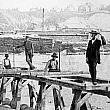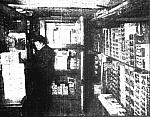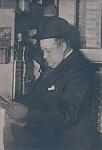Gypsum Mines
In 1898 William T. Powers began constructing a gypsum mine one hundred feet below the bed of the Grand River. The mine shaft was located at the most westerly span of the Blue Bridge, formerly the Grand Rapids & Indiana Railroad Bridge. Powers owned land on the west bank, extending from where the bridge crossed the river to the Sixth St. Bridge. At a depth of 60 feet a vein of plaster rock six feet in thickness was discovered. Immediately beneath this an extremely fine quality of plaster rock twelve feet thick ran under the river as far north as the Sixth St. Bridge.
The surface of the deposit was mapped and divided into squares about twenty feet each. Four of these were excavated and the fifth left to support the roof. In this way timbering was avoided and there was no danger of the roof caving in.
State law prescribed the manner in which the mines were worked. Pillars twenty-five feet square were maintained to support the roof of the mine. Then it was permitted to cut out the rock within a radius of twenty feet of each pillar. The roof could also be mined as there was a hard rock basis to the river bed.
The original area Powers mined covered about nine acres extending from the Pearl Street Bridge to the Fulton Street Bridge. Tons of gypsum were brought up the mine shaft daily to be converted into plaster and shipped all over the world.
When the plaster rock was mined is contained about 17 per cent water and it was necessary to remove it in order to make it a usable building material. The rock was first crushed, then ground between mill stones in the same manner that wheat was ground. The plaster flour was put into great pans holding eight to ten tons and heated until it boiled. During the process of boiling the plaster flour assumed the appearance of water with white coloring in it, but as soon as the water of crystallization was driven off the movement ceased and the plaster dropped to the bottom of the pans.
Mention Grand Rapids and people think of furniture, but that was not our first important industry. It was gypsum, or plaster, discovered in extensive surface beds along the creek named for its discovery—Plaster Creek. The first mill for grinding the gypsum, built by Daniel Ball and Warren Granger, was located where Plaster Creek crossed the Grandville Road. By 1850 they were producing 60 tons daily.
 The first gypsum quarry on the West Side of the Grand River was that of Richard Butterworth. The deposits there were not on the surface but many feet below layers of clay, limestone, and hard shale. At first gypsum was used extensively for fertilizer by farmers and only a minor portion for plaster and stucco. As population and building needs increased the proportions for farming and commercial use were reversed. Three other plaster mines were located south of John Ball Park, and plaster deposits run under the park itself.
The first gypsum quarry on the West Side of the Grand River was that of Richard Butterworth. The deposits there were not on the surface but many feet below layers of clay, limestone, and hard shale. At first gypsum was used extensively for fertilizer by farmers and only a minor portion for plaster and stucco. As population and building needs increased the proportions for farming and commercial use were reversed. Three other plaster mines were located south of John Ball Park, and plaster deposits run under the park itself.
Note: An excellent article in the January 1, 1907 Grand Rapids Evening Press, page 59, describes in detail the early history of the Grand Rapids gypsum mines.

 facebook
facebook






